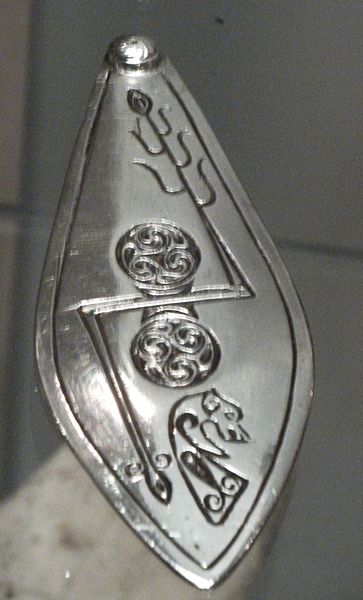It looks like you're using an Ad Blocker.
Please white-list or disable AboveTopSecret.com in your ad-blocking tool.
Thank you.
Some features of ATS will be disabled while you continue to use an ad-blocker.
share:
reply to post by Logarock
It could be, definitely worth holding in mind, I would say. It would certainly 'fit'. I wonder if that sea horse appears anywhere again, and if so, what's beside it?
I'm going to have a look.
It could be, definitely worth holding in mind, I would say. It would certainly 'fit'. I wonder if that sea horse appears anywhere again, and if so, what's beside it?
I'm going to have a look.
reply to post by beansidhe
Yes that type of seahorse and the stylized seahorse with actual horse head are all over the MEd in the old sea cultures.
Yes that type of seahorse and the stylized seahorse with actual horse head are all over the MEd in the old sea cultures.
reply to post by Logarock
Because it's so representative of that area, it could so easily 'stand for' a group or peoples. I'm going to check the other Pict stones asap and see where it appears again, specifically with tail and horse head
Because it's so representative of that area, it could so easily 'stand for' a group or peoples. I'm going to check the other Pict stones asap and see where it appears again, specifically with tail and horse head
Before seahorses, here's the cross again but in an unusual style:
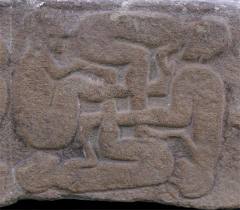
I have no idea what to make of that. There's also another Tree of Life:
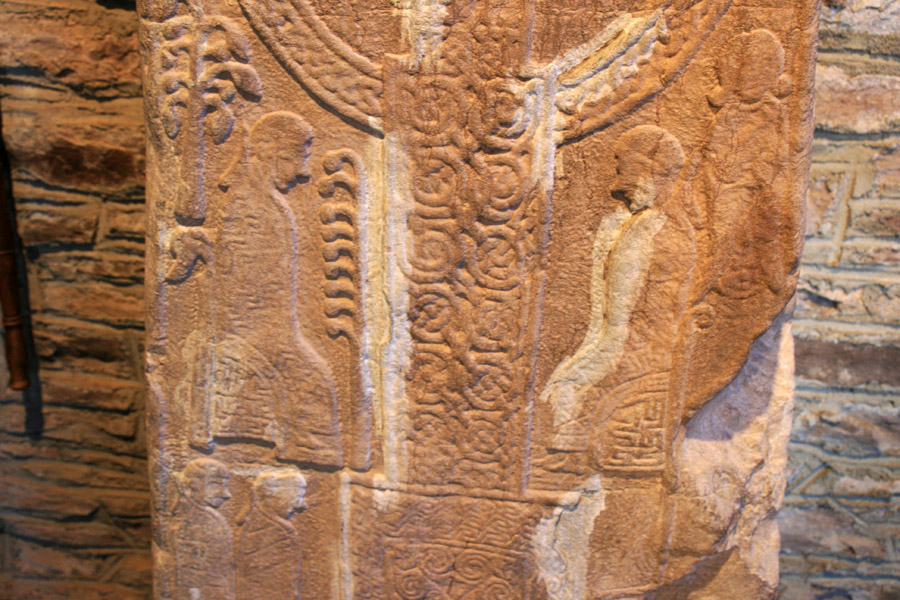
In fact, the woman on the right has the same hair as another stone. I think it's a sheep or a ram, but it has that hair. I've seen that style somewhere else, but I can't place it at the moment.
There are a few seahorses:
On the Brodie stone:
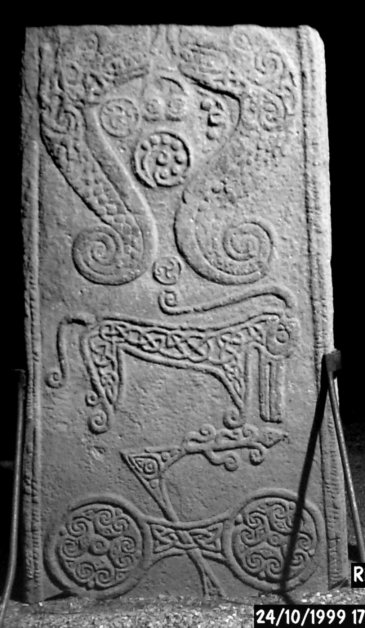
Largo stone:
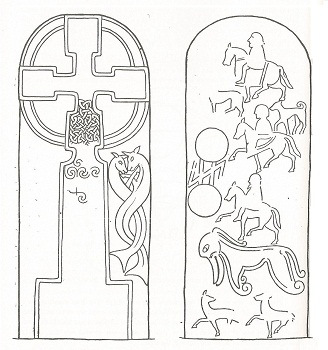
Aberlemno:
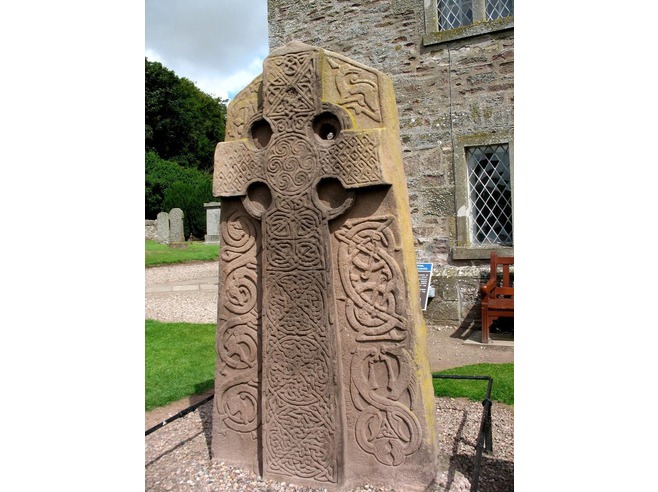
And the Fowlis Wester stone:
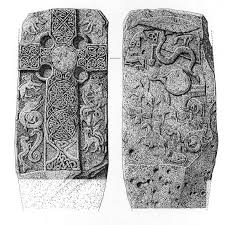
I want to get a better photo of the one above because it's actually the back of the stone with the winged figure/disc.

I have no idea what to make of that. There's also another Tree of Life:

In fact, the woman on the right has the same hair as another stone. I think it's a sheep or a ram, but it has that hair. I've seen that style somewhere else, but I can't place it at the moment.
There are a few seahorses:
On the Brodie stone:

Largo stone:

Aberlemno:

And the Fowlis Wester stone:

I want to get a better photo of the one above because it's actually the back of the stone with the winged figure/disc.
beansidhe
Before seahorses, here's the cross again but in an unusual style:
Solomon's knot
Endless Knot
Also check the 'additional links', there are a handful of interest.
Eternal Return
Indra's net
Namkha
Google for images on that one.
Sri Yantra
Eternal return (also known as "eternal recurrence") is a concept that the universe has been recurring, and will continue to recur, in a self-similar form an infinite number of times across infinite time or space.
Indra's net
Indra's net (also called Indra's jewels or Indra's pearls, from इंद्रजाल in Sanskrit) is a metaphor used to illustrate the concepts of emptiness,[2] dependent origination,[3] and interpenetration[4] in Hindu and Buddhist philosophy.
Namkha
Namkha (Tibetan: ནམ་མཁ nam mkha[1] "sky", "space", "aether"," heaven"), also known as De; (Tibetan mdos (མདོས) [2]) is a form of yarn or thread cross composed traditionally of wool or silk and is a form of the Endless knot of the Eight Auspicious Symbols (Ashtamangala)
Google for images on that one.
Sri Yantra
The Sri Yantra ("sacred instrument") or Sri Chakra ("sacred wheel") or Mahameru [3D] is a yantra formed by nine interlocking triangles that surround and radiate out from the central (bindu) point, the junction point between the physical universe and its unmanifest source.
reply to post by muzzleflash
Oh, thank you so much for that!

So it is.
ETA -that posted too soon. Solomon's knot is a depiction of an ancient belief in cyclical events?
Oh, thank you so much for that!

So it is.
ETA -that posted too soon. Solomon's knot is a depiction of an ancient belief in cyclical events?
Since the knot has been used across a number of cultures and historical eras, it can be given a range of symbolic interpretations.
Because there is no visible beginning or ending, it may represent immortality and eternity—as does the more complicated Buddhist Endless Knot.
Because the knot seems to be two entwined figures, it is sometimes interpreted as a Lover's Knot, although that name may indicate another knot.
Because of religious connections, the knot is sometimes designated the all-faith symbol of faith, but, at the same time, it appears in many places as a valued secular symbol of prestige, importance, beauty.
Solomon's Knot appears on tombstones and mausoleums in Jewish graveyards and catacombs in many nations. In this context, Solomon's Knot is currently interpreted to symbolize eternity.
edit on 14-3-2014 by beansidhe because: (no reason given)
edit on 14-3-2014 by beansidhe because: (no reason given)
reply to post by beansidhe
Swastika. Representative of a shield. IMHO. Also known as Solomons Knot as someone mentioned. Regularly found south of the border on stones, ancient carvings etc. Phoenician, Etruscan, Roman, East Indian all lay claim to its origins. Recognised these days by Hindus and some Muslims. I think it's time we got back to its original meaning and put Mr. A. H. to one side for now. It's a classic design and that's that.
Swastika. Representative of a shield. IMHO. Also known as Solomons Knot as someone mentioned. Regularly found south of the border on stones, ancient carvings etc. Phoenician, Etruscan, Roman, East Indian all lay claim to its origins. Recognised these days by Hindus and some Muslims. I think it's time we got back to its original meaning and put Mr. A. H. to one side for now. It's a classic design and that's that.
beansidhe
reply to post by muzzleflash
Oh, thank you so much for that!
You are welcome.
It's not exact or anything but it's close and can give ideas on associations and related theologies /symbolism around the world.
Hey check your u2us when you come back as well.
Hi guys,
I have nothing to add, other than to say Hi! and THANK YOU! for an interesting and fascinating thread.
I'm from Scotland, and the Scottish connections (which are piling up in here!!!) really amaze me!!
Brilliant work guys!
G
I have nothing to add, other than to say Hi! and THANK YOU! for an interesting and fascinating thread.
I'm from Scotland, and the Scottish connections (which are piling up in here!!!) really amaze me!!
Brilliant work guys!
G
beansidhe
reply to post by muzzleflash
Look at the Z rod on the brooch:
Absolutely stunning piece. That and the Whitecleuch Chain found in Lanarkshire at a depth of only 45cm. Incredible. These symbols pre-date the Iron age, let alone Silver...
What the hell is going on?
And still they can't be deciphered? Come on, we can do this if we all put our heads together.
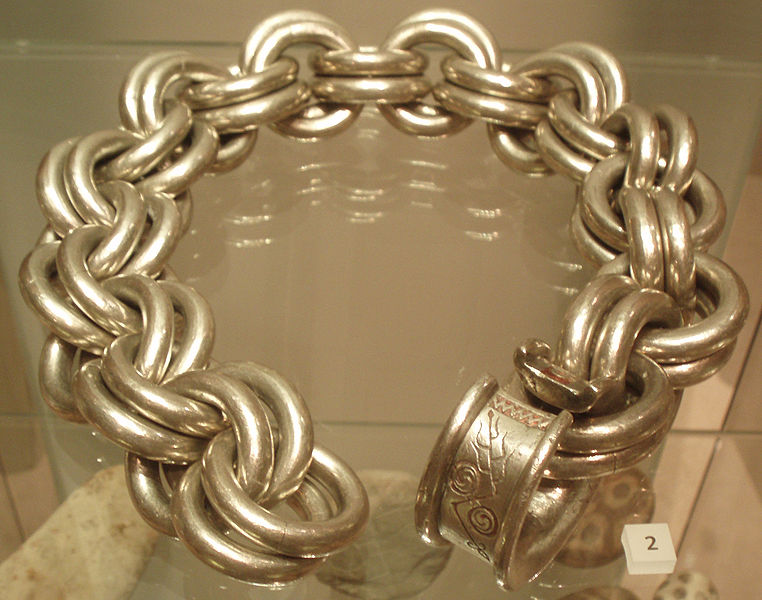

Phoenician metals surely. At the very least.
edit on 14/3/14 by Ramcheck because: typo
reply to post by Ramcheck
Ram,
It's just occured to me... could the "Z" part be crops? Wheat or Oats maybe? Passing through the two circle "rollers" like when they Roll Oats?
Might be a symbol which celebrates the harvest? or the bounty of nature?
G
Ram,
It's just occured to me... could the "Z" part be crops? Wheat or Oats maybe? Passing through the two circle "rollers" like when they Roll Oats?
Might be a symbol which celebrates the harvest? or the bounty of nature?
G
Gordi The Drummer
reply to post by Ramcheck
Ram,
It's just occured to me... could the "Z" part be crops? Wheat or Oats maybe? Passing through the two circle "rollers" like when they Roll Oats?
Might be a symbol which celebrates the harvest? or the bounty of nature?
G
It could totally be that. Most of the explanations I've read at least and I think Beansidhe would agree, point to the Z-Rods and V-Rods representing some kind of death / life / rebirth situation. This can apply to a harvest just as much as it can apply to the life and death of mankind. Just a question of figuring out why then they are then depicted on the stones. I intend to make a comprehensive list of stones and their symbols & locations soon.
Gordi The Drummer
Hi guys,
I have nothing to add, other than to say Hi! and THANK YOU! for an interesting and fascinating thread.
I'm from Scotland, and the Scottish connections (which are piling up in here!!!) really amaze me!!
Brilliant work guys!
G
Gordi, friend, it's good to see you!
I'm glad you're enjoying this as much as me. I didn't know this much about Scotland, until I started and I am just fascinated by it. Every single contribution on this thread has been helpful and educational, so if there's anything at all you want to say, then say it!
We're going to figure this out, I know we are!
reply to post by Ramcheck
Aah, too widespread to help? I hoped it would be the very thing that would lead someone to say 'aargh - it's first century Etruscan!!' or something like that.
Ok, we'll keep going!
Agreed, it is shameful that these stones are not regarded more highly in Britain, and that we should know exactly what they are saying. I still can't quite believe that this knowledge has all been lost. But I found the hair, so I'll be back soon...!
I found this collection of stones on someone's flickr account by chance and it gives different views of them than the stones database. It's good to see. Also, good thinking -are any symbols specific only to certain locations. I like the way you're thinking
Flickr -kyle munro
(Hope you don't mind, if you ever notice this Kyle.)
Swastika. Representative of a shield. IMHO. Also known as Solomons Knot as someone mentioned. Regularly found south of the border on stones, ancient carvings etc. Phoenician, Etruscan, Roman, East Indian all lay claim to its origins. Recognised these days by Hindus and some Muslims. I think it's time we got back to its original meaning and put Mr. A. H. to one side for now. It's a classic design and that's that.
Aah, too widespread to help? I hoped it would be the very thing that would lead someone to say 'aargh - it's first century Etruscan!!' or something like that.
Ok, we'll keep going!
Agreed, it is shameful that these stones are not regarded more highly in Britain, and that we should know exactly what they are saying. I still can't quite believe that this knowledge has all been lost. But I found the hair, so I'll be back soon...!
I intend to make a comprehensive list of stones and their symbols & locations soon.
I found this collection of stones on someone's flickr account by chance and it gives different views of them than the stones database. It's good to see. Also, good thinking -are any symbols specific only to certain locations. I like the way you're thinking
Flickr -kyle munro
(Hope you don't mind, if you ever notice this Kyle.)
edit on 15-3-2014 by beansidhe because: ETA link
beansidhe
We're going to figure this out, I know we are!
One thing I know for sure in life, is that what you just said works!
To just believe in ourselves and give it our best shot,
and to be willing to risk being wrong in hopes of learning better, that's all it takes.
It's never easy but it's always rewarding if even not immediately!
reply to post by muzzleflash
And that, my beautiful friend, is what it's all about. And I have been so lucky on this thread to meet people who have the sticking power, the brains and the passion to figure this out. We're going to get things wrong again, but we'll get there.
Thanks for that reminder, Muzz x
And that, my beautiful friend, is what it's all about. And I have been so lucky on this thread to meet people who have the sticking power, the brains and the passion to figure this out. We're going to get things wrong again, but we'll get there.
Thanks for that reminder, Muzz x
The hair is from Hathor, the Goddess of Love:
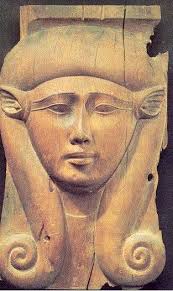
She is nearly always shown like that, so much so that she is defined by her hair. It could be a coincidence, but it's another possibility to bear in mind.

She is nearly always shown like that, so much so that she is defined by her hair. It could be a coincidence, but it's another possibility to bear in mind.
On the left hand side, halfway down is the sheep I was thinking of:
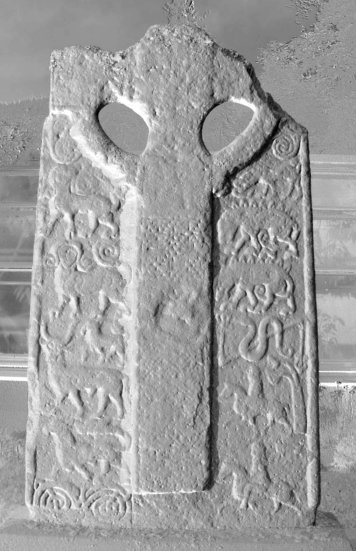
Hathor
And yes, before anyone asks, I do feel like an idiot for thinking that was a sheep.

While other ancient Egyptian hairstyles are instantly recognizable even today as solely Egyptian, the Hathor hair-do seems to have set an international style, in particular traveling all over the Middle East. Other goddesses are depicted wearing this style, in fact it seems to have become the goddess hairstyle, favored by all the most fashionable deities. In Mesopotamia, the beautiful and stylish, ever youthful if fierce, Ishtar dresses her hair this way. So do the beautiful Western Semitic love and war goddesses, Anat and Astarte, who would eventually achieve great popularity in ancient Egypt, perhaps the only foreign deities to do so. They would become incorporated into Egyptian mythology, serving as the designated consolation prize brides for Seth, in the face-saving compromise that concludes his loss to Horus. Anat and Astarte, the ancient equivalent of hot foreign babes, of course wear only the most stylish of hairdos. Technically, we have no way of actually knowing where this hair-do originated or with whom. However, Hathor's influence remains so consistent that no matter where an ancient goddess plaque is dug up, if she's wearing that flip, she is automatically described as wearing the Hathor hair do. What the goddesses who wear this style have in common with Hathor beyond celestial beauty is a willingness to boldly battle on behalf of justice, their families and followers. Ishtar, Anat and Hathor: these images of beauty are not passive or vain but action-oriented brave women...
Hathor
And yes, before anyone asks, I do feel like an idiot for thinking that was a sheep.
beansidhe
The hair is from Hathor, the Goddess of Love:
She is nearly always shown like that, so much so that she is defined by her hair. It could be a coincidence, but it's another possibility to bear in mind.
I'll show them the "Prince" part first since it's so astonishing and easy to grasp.
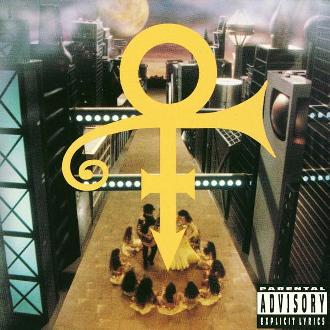
Love Symbol Album
Ok so we have the what matches the "Hair of Hathor" symbolism, but here on Prince's "Love Symbol Album".
Hathor is what? LOVE...
The Arrow points down on the cover...to what???
The Coven Of Lovin - of the Cow Oven
And the "Prince" = Lucky # 13
I'll try to organize the rest of the flow and post it up later.
This was the end of where I got when she brought up "Hathor", and there are various steps that lead to this.
I need a break, but I had to post this it's TOO FUNNY!
new topics
-
Bucks County commissioners vote to count illegal ballots in Pennsylvania recount
2024 Elections: 1 hours ago -
Trump sues media outlets -- 10 Billion Dollar lawsuit
US Political Madness: 2 hours ago -
Fired fema employee speaks.
US Political Madness: 2 hours ago -
How long till it starts
US Political Madness: 4 hours ago -
USSS Agent Fired for Having Sex In Michelle Obama's Bathroom
US Political Madness: 5 hours ago -
Watching TV
Jokes, Puns, & Pranks: 8 hours ago
top topics
-
RFK is Trumps health pick
2024 Elections: 16 hours ago, 20 flags -
Trump sues media outlets -- 10 Billion Dollar lawsuit
US Political Madness: 2 hours ago, 11 flags -
How long till it starts
US Political Madness: 4 hours ago, 10 flags -
Fired fema employee speaks.
US Political Madness: 2 hours ago, 9 flags -
USSS Agent Fired for Having Sex In Michelle Obama's Bathroom
US Political Madness: 5 hours ago, 8 flags -
Bucks County commissioners vote to count illegal ballots in Pennsylvania recount
2024 Elections: 1 hours ago, 8 flags -
Watching TV
Jokes, Puns, & Pranks: 8 hours ago, 6 flags
active topics
-
Mike Tyson returns 11-15-24
World Sports • 40 • : Blueracer -
The Trump effect 6 days after 2024 election
2024 Elections • 123 • : cherokeetroy -
Trump sues media outlets -- 10 Billion Dollar lawsuit
US Political Madness • 3 • : Astrocometus -
WATCH LIVE: US Congress hearing on UFOs, unidentified anomalous phenomena
Aliens and UFOs • 71 • : putnam6 -
Chancellor Rachel Reeves - Former Colleagues Say She Lied About Role as ‘Economist’
Politicians & People • 3 • : gortex -
-@TH3WH17ERABB17- -Q- ---TIME TO SHOW THE WORLD--- -Part- --44--
Dissecting Disinformation • 3274 • : Thoughtful3 -
How long till it starts
US Political Madness • 5 • : Astrocometus -
The art of being offended
Social Issues and Civil Unrest • 48 • : TimBurr -
Fired fema employee speaks.
US Political Madness • 6 • : xuenchen -
RFK is Trumps health pick
2024 Elections • 10 • : nugget1

